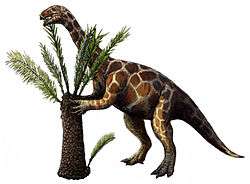Unaysaurus
| Unaysaurus Temporal range: Late Triassic, 225 Ma | |
|---|---|
 | |
| Restoration | |
| Scientific classification | |
| Kingdom: | Animalia |
| Phylum: | Chordata |
| Class: | Reptilia |
| Clade: | Dinosauria |
| Order: | Saurischia |
| Suborder: | †Sauropodomorpha |
| Clade: | †Plateosauria |
| Family: | †Plateosauridae |
| Genus: | †Unaysaurus Leal, Azevodo, Kellner, & da Rosa, 2004 |
| Type species | |
| U. tolentinoi Leal et al., 2004 | |
Unaysaurus is a genus of sauropodomorph herbivore dinosaur. Discovered in southern Brazil, in the geopark of paleorrota, in 1998, and announced in a press conference on Thursday, December 3, 2004, it is one of the oldest dinosaurs known. It is closely related to plateosaurid dinosaurs found in Germany, which indicates that it was relatively easy for species to spread across the giant landmass of the time, the supercontinent of Pangaea.[1]
Like most early dinosaurs, Unaysaurus was relatively small, and walked on two legs. It was only 2.5 meters long (8.2 ft), 70 to 80 centimeters tall (2 to 3 ft), and weighed about 70 kilograms (155 lb).
The fossils of Unaysaurus are well preserved. They consist of an almost complete skull, complete with a lower jaw, and partial skeleton with many of the bones still connected to each other in their natural positions. It is one of the most complete dinosaur skeletons (including complete skull) ever recovered in Brazil.
Discovery and naming
Unaysaurus was found in the southern Brazilian state of Rio Grande do Sul, near the city of Santa Maria. It was recovered from the red beds of the Caturrita Formation, which is the geologic formation where similarly old dinosaurs like Saturnalia have been found. The oldest dinosaurs in the world are from here and nearby in Argentina (like the Eoraptor), which suggests that the first dinosaurs may have originated in the area.
The new species and genus were officially described by Luciano A. Leal, Sergio A. K. Azevodo, Alexander W. A. Kellner, and Átila A. S. da Rosa in the October 18, 2004 issue of the scientific journal Zootaxa. The name Unaysaurus comes from the word unay (u-na-hee), meaning "black water" in the local Tupi language, which in turn refers to Agua Negra (also "black water"), the Portuguese name for the region where the fossils were found. The species epithet tolentinoi is named after Tolentino Marafiga, who discovered the fossils by the side of a road in 1998.[1]
Classification
Unaysaurus is the first prosauropod discovered in Brazil. Plateosaurids were semi-bipedal, herbivorous dinosaurs that are related to the later and more advanced sauropods, which include some of the largest creatures ever to walk the Earth, like the Brachiosaurus. Staurikosaurus, another early dinosaur, has been discovered nearby, and it is possible that Teyuwasu, another Brazilian dinosaur described in 1999, is also a plateosaurid.[1]
Counter to expectations, however, the closest relative of Unaysaurus is not from South America. It is mostly closely related to the Plateosaurus, which lived about 210 million years ago in Germany. This indicates that species were able to migrate relatively easily across Pangaea.[1]
Paleoecology
Unaysaurus lived between about 200 to 225 million years ago, in the Carnian or Norian age of the late Triassic period. It was found in the south of Brazil, which at the time was connected to northwest Africa. The whole world was united into the great supercontinent of Pangaea, which was just starting to divide into Laurasia in the north, and Gondwana in the south.[1]
The Caturrita Formation has uncovered a wide variety of fauna, although the formation is also referred to as upper portion of the Santa Maria 2 Sequence. Multiple dinosauriforms are represented in the rock of the formation, including Sacisaurus agudoensis, the sauropodomorph Unaysaurus tolentoi, and the theropod Guaibasaurus candelariensis,[2] all of which are not found anywhere else.[1] The basal archosaurs Jachaleria candelariensis (a dicynodont), an unclassified phytosaur, and isolated teeth of archosaur origin can also be unearthed in the formation. A single stereospondyl amphibian is known from the formation, but has not yet been identified specifically.[2]
An extremely rich amount of small tetrapods have been recovered from the Caturrita Formation, which is quite surprising. They measure less than 15 cm (5.9 in). Species preserved are the procolophonid Soturnia caliodon, the lepidosaur Cargninia enigmatica, the sphenodontid Clevosaurus brasiliensis, and some small mammals coexisting with Faxinalipterus minima, a pterosaur. The mammals include Riograndia guaibensis, Brasilodon quadrangularis, Brasilitherium riograndensis, Irajatherium hernandezi and Minicynodon maieri.[2]
References
- 1 2 3 4 5 6 Leal, L.A.; Azevodo, S.A.K.; Kellner, A.A.W.; da Rosa, A.A.S. (2004). "A new early dinosaur (Sauropodomorpha) from the Caturrita Formation (Late Triassic), Paraná Basin, Brazil" (PDF). Zootaxa. 690: 1–24.
- 1 2 3 Soares, M.B.; Schultz, C.L.; Horn, B.L.D. (2011). "New information on Riograndia guaibensis Bonaparte, Ferigolo & Ribeiro, 2001 (Eucynodontia, Tritheledontidae) from the Late Triassic of southern Brazil: anatomical and biostratigraphic implications". Anais da Academia Brasileira de Ciências. 83 (1). doi:10.1590/S0001-37652011000100021. ISSN 0001-3765.
External links
- Kingstone, Steve (2004-12-03). "New dinosaur uncovered in Brazil". BBC News.
- Khalip, Andrei (2004-12-02). "Brazilians find dinosaur linked to Europe". MSNBC.
- "New dinosaur uncovered". News 24. 2004-12-03.
- Dinosaurs of Rio grande do Sul.